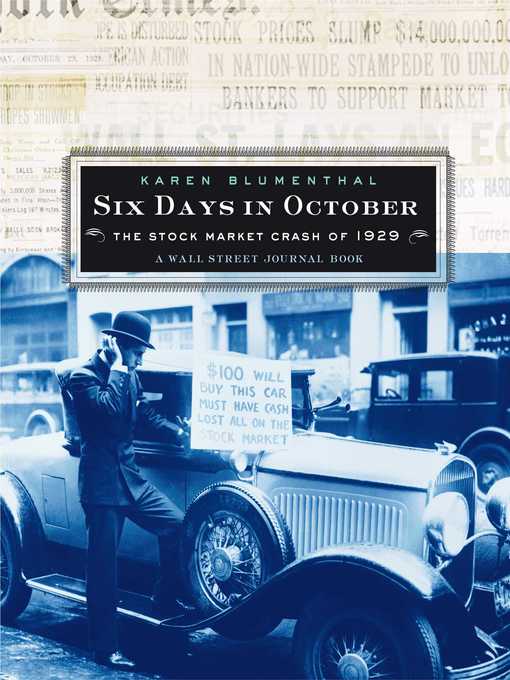
Six Days in October
The Stock Market Crash of 1929; a Wall Street Journal Book for Children
فرمت کتاب
ebook
تاریخ انتشار
2013
Lexile Score
1040
Reading Level
6-8
ATOS
7.9
Interest Level
9-12(UG)
نویسنده
Karen Blumenthalشابک
9781442488915
کتاب های مرتبط
- اطلاعات
- نقد و بررسی
- دیدگاه کاربران
نقد و بررسی

Starred review from September 2, 2002
This fast-paced, gripping (and all-too-timely) account of the market crash of October 1929 puts a human face on the crisis. Blumenthal, the Dallas bureau chief of the Wall Street Journal,
sets the scene in the affluent post–Great War society: she reproduces the famous January 1929 cartoon from Forbes
magazine (a frenetic crowd grasping at a ticker tape) and her statement "Executives who had spent their lives building solid reputations cut secret deals in pursuit of their own stock-market riches" may send a shiver down the spines of older readers aware of recent corporate scandals. The author deciphers market terms such as bull and bear, stock and bond in lucidly worded sidebars and describes the convergence of speculation, optimism and greed that primed the market for failure. Throughout, Blumenthal relates the impact of historical developments on everyday citizens. Supported by archival photographs, cartoons and documents, the text is rife with atmospheric detail about the customs of the stock exchange (from buttonhole flowers to the opening and closing gongs). Other asides, such as the first appearance of women on the exchange floor, or the rise (and fall) of immigrant Michael J. Meehan, who championed the stock of Radio Corporation, continue to keep the focus on the human element. Blumenthal ably chronicles the six-day descent and exposes the personalities, backroom machinations and scandals while debunking several popular myths about the crash (e.g., that it caused mass suicide and the Great Depression). A compelling portrait of a defining moment in American history. Ages 12-up.

October 1, 2002
Gr 8 Up-In this thoroughly researched work, Blumenthal focuses on the days leading up to and including the crash. Her account attempts to show that the event was not the result of one very bad day on Wall Street, but a culmination of unwise decisions and rampant speculation on the part of the American public, as well as banking and financial institutions. The dense text is filled with the specifics of the stock market and how it was turned on its head. Blumenthal does not delve into the economic depression the country faced after the crash, but concludes that the crash in and of itself was not the cause of the Great Depression. Many black-and-white, period photos; political cartoons; and reproductions of pages from newspapers, letters, and advertisements complement the text, rendering more reality to the story of an almost incomprehensible loss of fortunes and life savings. Chapter notes and other source material are included. Overall, this is a solid account of an important chapter in American history that offers more detail than Nathan Aaseng's The Crash of 1929 (Lucent, 2001).-Carol Fazioli, formerly at The Brearley School, New York City
Copyright 2002 School Library Journal, LLC Used with permission.

November 1, 2002
Gr. 7-12. A " Wall Street Journal "bureau chief, Blumenthal combines a fascinating overview of the infamous stock market crash in 1929 with a rare and useful primer of financial basics. The chapters follow the six days surrounding the crash, but Blumenthal deftly places the events in context with vivid accounts of the stock-market fever that preceded the crash, often showing the impact of abstract issues through individual stories--the losses of Groucho Marx and of General Motors' founder William Durant are particularly astonishing. Rapid, simply constructed sentences increase the drama and suspense while making difficult concepts easily understood. Throughout, fact boxes define financial vocabulary--stocks, bonds, bulls and bears, margins, the measure of a company's worth, and more--in clear language that is both compelling and instructive. Archival images--photos, cartoons, and reproduced documents--enhance the text, as do frequent excerpts from newspapers and political quotes from the era. Students using this for research may be frustrated by the source citations, which appear as an appended, generalized chapter-by-chapter listing of materials consulted rather than as specific notes that correspond to text passages. But this still offers a riveting history, along with the basic terminology needed to grasp the events and to draw parallels between the volatile, sometimes corrupt, market of 1929 and the market today.(Reprinted with permission of Booklist, copyright 2002, American Library Association.)

























دیدگاه کاربران